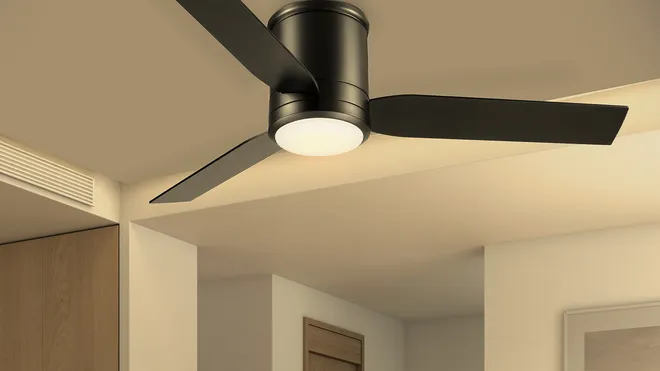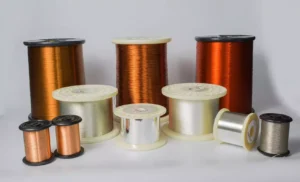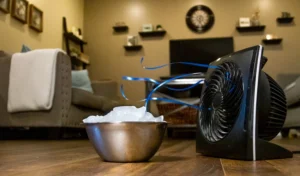Feeling the summer heat?
A ceiling fan offers great relief, but its direction is key.
Running it the wrong way can make your room feel stuffy and uncomfortable.
Ceiling fans rotate anticlockwise in summer to create a direct downdraft.
This column of air moves down and out across the room, creating a cooling breeze.
This “wind chill” effect helps evaporate sweat, making you feel cooler.
This simple adjustment is the secret to maximizing your fan’s cooling power without touching the thermostat.
But there’s more to it than just a summer breeze.
The direction you choose in winter can also make a huge difference.
Let’s explore how to use your fan perfectly all year round.
The Anticlockwise Rotation for Summer Cooling
Is your room hot even with the fan on?
You might be using the wrong setting.
The direction of rotation is crucial for effective cooling during warm weather.
Typically, ceiling fans should rotate anticlockwise in the summer.
This motion is specifically designed to push air straight down, creating a breeze that makes a room feel more comfortable and cooler during warm weather.
The standard rotation for ceiling fans in warm weather is anticlockwise, as viewed from below.
This specific direction is not random; it is engineered to maximize the fan’s cooling ability.
The primary goal is to create a direct downdraft of air within the room.
When the blades spin anticlockwise, they are angled to scoop the air and push it downwards.
This creates a focused column of moving air that you can feel when you stand directly underneath it.
How it Creates a Cooling Effect
The cooling sensation you get from a fan isn’t from a change in the room’s temperature.
A fan does not actually lower the temperature of the air.
Instead, it creates a phenomenon known as the “wind chill effect”.
This effect happens when the moving air passes over your skin, speeding up the evaporation of sweat.
This process of evaporation draws heat away from your body, making you feel cooler.
So, while the thermometer in the room won’t show a different reading, your body will perceive the environment as being more comfortable.
This is why a fan is so effective in warmer climates and during hot summer months.
Air Circulation Benefits
Beyond the direct wind chill effect, the anticlockwise rotation helps to circulate the air throughout the entire room.
The air pushed down by the fan spreads across the floor and then moves towards the walls, where it rises back up toward the ceiling.
This continuous loop prevents air from becoming stagnant and stuffy.
Proper air circulation ensures that the cooling effect is distributed more evenly across the space, rather than being confined to one spot.
This makes the entire room feel fresher and more pleasant.
By using the anticlockwise setting, you are using the fan exactly as it was designed for summer comfort.
The Clockwise Rotation for Winter Warmth
Feeling a chill in the winter even with the heat on?
Your ceiling fan can surprisingly help.
A simple change in its rotation can make your space feel warmer.
In colder months, ceiling fans should rotate in a clockwise direction.
This motion pulls cool air upward, which then forces the warm air that has risen and collected near the ceiling to circulate down the walls and throughout the room.
While the anticlockwise direction is for cooling, the clockwise rotation serves the opposite purpose and is ideal for colder seasons.
To achieve this, the fan’s motor is reversed.
Instead of pushing air down, the blades, now spinning clockwise, are angled to pull the air in the room upward toward the ceiling.
This might seem counterintuitive, as you don’t want a cool breeze in the winter.
However, the effect is indirect and very effective at distributing heat.
How Updraft Works in Winter
The principle behind the clockwise rotation is based on the simple fact that warm air rises.
In any heated room, the warmest air naturally accumulates near the ceiling, while the cooler air settles closer to the floor.
When the fan runs in a clockwise direction, it creates an updraft.
It gently pulls the cooler air from the lower parts of the room upwards.
This flow of air then displaces the trapped layer of warm air at the ceiling.
The warm air is pushed out towards the walls and then circulates back down into the living space.
The result is a more even distribution of heat throughout the room, from floor to ceiling.
This process helps to eliminate cold spots and creates a more consistently comfortable environment.
Who Benefits Most?
This function is especially useful in rooms with high ceilings, where a significant amount of heat can get trapped far above the living area.
By running the fan in a clockwise direction, you can reclaim that lost heat and circulate it back where you need it.
This can make the room feel warmer without needing to turn up your heating system.
This gentle circulation of warm air happens without creating a noticeable draft, so you get the benefit of the warmth without the cooling breeze associated with summer fan use.
| Season | Recommended Direction | Airflow | Purpose |
| Summer | Anticlockwise / Counter-clockwise | Downdraft | Creates a cooling wind chill effect. |
| Winter | Clockwise | Updraft | Circulates trapped warm air from the ceiling. |
Can Fan Rotation Really Save You Money?
Are high energy bills a concern?
Your ceiling fan is a powerful tool for savings.
Using it correctly can lower costs in both summer and winter.
Yes, using a ceiling fan correctly can lead to significant savings on energy bills.
In summer, the fan’s cooling effect allows you to use your air conditioner less, and in winter, it helps distribute heat more efficiently, reducing your heating system’s workload.
A ceiling fan is one of the most energy-efficient appliances you can use to manage your home’s climate.
When used strategically alongside your primary heating and cooling systems, it can make a real difference in your energy consumption.
The key is to change the fan’s direction seasonally to match your needs.
A fan itself uses much less electricity than an air conditioning unit or a central heating system, so making it do some of the work can lead to substantial savings.
Summer Savings
During warmer months, a ceiling fan set to rotate anticlockwise creates a cooling breeze.
This breeze makes you feel cooler, allowing you to raise the thermostat on your air conditioner by a few degrees without sacrificing comfort.
The AC unit, therefore, doesn’t have to work as hard or run as often to keep the room at a comfortable temperature.
Since air conditioning is often a major contributor to high summer electricity bills, this reduced reliance can lead to noticeable savings.
You get to feel cool while consuming significantly less energy.
Winter Savings
In the cooler months, the strategy is reversed.
By switching the fan to rotate clockwise, you can help manage your heating costs.
This direction pulls cool air up and pushes the warm air that has collected near the ceiling back down into the room.
This process helps to distribute heat more evenly, making the room feel warmer at a lower thermostat setting.
Your heating system won’t need to cycle on as frequently to maintain the desired temperature.
By preventing heat from being wasted at the ceiling, the fan helps your heating system operate more efficiently, which in turn leads to lower energy costs during the winter.
It’s a simple adjustment that can have a big impact on your budget.
How to Change Your Ceiling Fan’s Direction
Ready to switch your fan’s direction but not sure how?
It’s a simple process.
A quick adjustment can set you up for comfort in any season.
To change your fan’s direction, first turn it off and wait for the blades to stop.
Then, find the small toggle switch on the motor housing and flip it to the opposite position.
Some fans may use a remote control instead.
Changing the direction of your ceiling fan is a straightforward task that you should do seasonally to ensure you’re getting the right kind of airflow.
For summer, you want an anticlockwise rotation for a cooling breeze, and for winter, a clockwise rotation to distribute warm air.
Most fans make this change very easy, typically through a switch on the fan’s body or a setting on a remote.
Using the Motor Switch
The most common method for changing the fan’s direction involves a physical switch on the fan itself.
Here is a step-by-step guide:
- Safety First: Always begin by turning off the ceiling fan at the wall switch or pull cord and wait for the blades to come to a complete stop.This is crucial for your safety and to prevent damage to the fan’s motor.
- Locate the Switch: Once the blades have stopped, locate the direction switch.It is usually a small, horizontal or vertical toggle switch on the motor housing, which is the central part of the fan where the blades are attached.You may need a step ladder to reach it safely.
- Flip the Switch: Simply slide or flip the switch to the opposite position.There often isn’t an indicator for “summer” or “winter,” so you’ll just move it to the other side.
- Test the Direction: Turn the fan back on and check that the blades are spinning in the desired direction.You can stand underneath it to observe the movement.If it’s summer, you should feel a breeze.If it’s winter, you should not feel a strong draft directly below.If it’s still going the wrong way, turn it off and double-check the switch.
Using a Remote or Wall Control
Many modern ceiling fans offer more convenient ways to change the blade direction.
If you don’t see a switch on the motor housing, check for other options.
- Remote Control: If your fan came with a remote, it likely has a button for reversing the fan’s direction.This button is often marked with an icon showing curved arrows.This allows you to change the setting without needing a ladder.
- Wall Switches: Some high-end fan systems are operated by a special wall control panel that includes a reverse function.
- Pull Cord: On certain models, a dedicated pull cord is used to reverse the motor’s direction.
Always check your fan’s user manual if you are unsure how to change its direction.
The Physics Behind a Fan’s Spin
Ever wondered what makes a fan turn?
It’s not magic, but science.
A simple motor and a core scientific principle are at the heart of its rotation.
A fan rotates because an electric motor converts electrical energy into mechanical energy.
This process is based on electromagnetism, where an electric current creates a magnetic field that interacts with a rotor, causing it to spin the fan’s blades.
The rotation of a ceiling fan is a perfect example of applied physics at work in our homes.
At its core, the fan is powered by a type of electric motor.
This motor is the engine that drives the entire operation.
It takes electrical energy from your home’s wiring and transforms it into the mechanical, spinning motion that we see.
The speed and even the direction of this rotation can be adjusted by controlling the electrical current that flows into the motor, which you do via a wall switch, pull cord, or remote control.
Electromagnetism in Action
The fundamental principle that makes the motor spin is electromagnetism.
Inside the motor, there are two key parts: the stator and the rotor.
When you turn the fan on, an electric current flows through coils of wire in the motor, creating a magnetic field.
This magnetic field interacts with another set of magnets or coils on the rotor, which is the part that rotates.
The attraction and repulsion between these magnetic fields create a force that causes the rotor to turn.
In the specific case of many ceiling fans, the armature winding is placed on a fixed rotor shaft, which causes the outer part, the stator where the blades are attached, to rotate.
This is what you see spinning above you.
Why Blade Design Matters
While the motor provides the power to spin, the design of the fan blades determines the direction of the airflow.
Technically, a fan could spin in either direction and still move air.
The crucial element is the pitch, or tilt, of the blades.
The blades are angled to push air in a specific direction as they rotate.
For an anticlockwise rotation to create a downdraft, the blades are tilted with the leading edge higher than the trailing edge.
When the direction is reversed to clockwise, the same tilt causes the blades to draw air upward.
Manufacturers stick to a universal standard for this design, which is why the summer and winter directions are so consistent across different models.
Do All Ceiling Fans Have a Directional Switch?
Thinking of reversing your fan but can’t find the switch?
Not all fans have one.
The ability to change direction depends on the fan’s model and age.
No, not all ceiling fans have a switch to change the blade direction.
While most modern fans include this feature via a switch or remote, many older or budget-friendly models are designed to rotate in only one direction.
The feature of a reversible motor is common in modern ceiling fans, but it is not universal.
Whether or not your fan can change direction depends heavily on its design, cost, and when it was made.
Most standard fans sold today for residential use are built with a reversible motor because the year-round functionality is a major selling point.
However, if you have an older fan or a more basic, budget-friendly model, it might lack this feature entirely.
Some very compact or industrial-style fans may also be designed for single-direction airflow only.
How to Check Your Fan
If you’re not sure about your fan, the first step is a visual inspection.
Safely get close enough to the fan’s motor housing and look for a small toggle switch.
If you find one, your fan is reversible.
If there is no switch, don’t assume it can’t be reversed just yet.
There are other possibilities.
Alternative Reversing Methods
Manufacturers have integrated the reverse function in several ways, not just with a switch on the motor.
- Remote Control: Many contemporary fans come with a remote control that includes a button for changing the direction.This is the most convenient option, as it doesn’t require a ladder.
- Wall Control: Some integrated systems use a special wall switch that has controls for fan speed, lighting, and the reverse function.
- Pull Cord: Less common, but some fans have a dedicated pull cord that, when pulled, reverses the motor’s direction.
If your fan has none of these features—no switch on the body, no reverse button on the remote or wall panel, and no specific pull cord—it is likely a single-direction fan.
In some very rare older models, the direction could theoretically be changed by manually flipping the fan blades, but this is not a standard or recommended practice for modern fans.
These single-direction fans are typically designed to rotate anticlockwise for general cooling purposes.
Conclusion
In short, a fan’s rotation direction is key for comfort and savings.
Use anticlockwise in summer for cooling and clockwise in winter for warmth to make your home comfortable year-round.
FAQs
What happens if a ceiling fan runs backward in summer?
If a fan runs backward (clockwise) in summer, it pulls air up instead of creating a cooling downdraft.
This will circulate warm air from the ceiling, making the room feel warmer and stuffier.
Does it matter which way a fan spins?
Yes, it matters greatly.
Anticlockwise rotation creates a cooling breeze for summer, while clockwise rotation helps distribute trapped warm air in winter, making it useful for year-round comfort.
How do I know if my fan is in winter or summer mode?
Stand under the fan while it’s on.
If you feel a distinct cool breeze, it’s in summer mode (anticlockwise).
If you don’t feel a strong draft, it’s in winter mode (clockwise).
Does a fan actually cool a room?
No, a fan does not lower the actual room temperature.
It creates a wind chill effect that makes you feel cooler by helping sweat evaporate from your skin more quickly.
Can you run a ceiling fan 24/7?
Modern ceiling fans are designed to run for long periods.
However, for energy savings, it’s best to turn them off when you leave the room, as their cooling effect only benefits people, not the room itself.
Why do some ceiling fans have a light?
Many ceiling fans include a light fixture for convenience, combining two essential room features into one.
This saves ceiling space and provides a central source of both air circulation and illumination.







